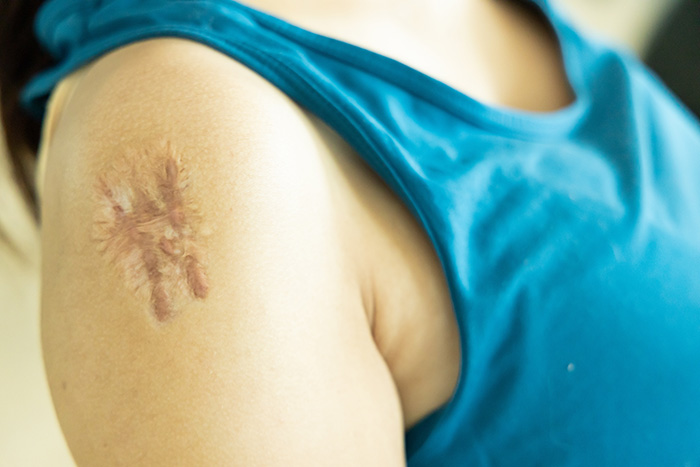What is Laser Scar Treatment
In the pursuit of smooth, flawless skin, scars can often feel like an insurmountable obstacle. However, advancements in dermatological treatments have brought a highly effective solution to the forefront: laser treatment for scars. This innovative approach not only promises significant improvements in the appearance of scars but also enhances the overall health of the skin. In this comprehensive guide, we’ll dive deep into how laser treatment works, the types of scars it can address, and what you can expect from the procedure.
Understanding Laser Treatment for Scars
Laser treatments have revolutionised the approach to scar reduction, offering a sophisticated method to minimise the appearance of various types of scars. However, for optimal results, it’s often recommended to combine laser therapy with steroid injections, especially in the treatment of certain scar types like keloids and hypertrophic scars. This combination approach leverages the unique benefits of both treatments to achieve the best possible outcome.
Steroid Injections: Enhancing Laser Treatment Outcomes
Steroid injections, specifically corticosteroids, are known for their potent anti-inflammatory properties. When used in the context of scar treatment, they can effectively reduce the size, thickness, and discomfort associated with raised scars. Steroids work by breaking down the excess collagen fibers that contribute to the scar’s raised appearance.
For a greater understanding of how steriods are used and the effect they have during scar treatment, vist National Library of Medicine.
Types of Scars Treatable with Lasers
Laser therapy is versatile, capable of addressing a wide range of scars, including:

Acne Scars:
Acne scars are the aftermath of severe acne, presenting in various forms such as ice pick scars, rolling scars, and boxcar scars. Laser treatments like fractional laser therapy can penetrate deep into the layers of the skin, stimulating collagen production and skin renewal. This process helps to smooth out the texture and reduce the depth of acne scars, making them less noticeable.

Surgical Scars:
Surgical scars result from incisions in the skin during medical procedures. These scars can vary in size and appearance, depending on the nature of the surgery and the individual’s healing process. Laser treatment for surgical scars works by removing the top layers of scar tissue and encouraging the growth of new, healthy skin. Over time, this can make the scars softer, less raised, and more consistent with the surrounding skin tone.

Traumatic Scars:
Traumatic scars are formed due to injuries such as cuts, burns, or abrasions. Depending on the injury’s severity and location, these scars can be particularly noticeable and disfiguring. Laser treatments can effectively improve the appearance of traumatic scars by reducing their redness, smoothing their texture, and blending them more seamlessly with the surrounding skin.

Keloid Scars:
Keloid scars are thick, puckered, itchy clusters of scar tissue that grow beyond the edges of the wound or incision. They are more common in people with darker skin and can be caused by surgery, acne, piercings, tattoos, or even minor scratches. Laser for keloid scars typically involves the use of fractionated laser technology to target and remove the excess scar tissue while minimising damage to the surrounding skin. It can also help reduce the scar’s redness and discomfort.
For a deeper dive into Keloids visit National Library of Medicin

Hypertrophic Scars:
Hypertrophic scars are raised scars that are similar to keloids but don’t grow beyond the boundary of the original wound. They can be red, thick, and raised initially, becoming darker and flatter over time. Lasers can effectively treat hypertrophic scars by reducing their thickness and improving their coloration, making them less noticeable against the skin.
Discover the difference between Keloid and Hypertrophic scars

Stretch Marks:
Stretch marks, or striae, are a form of scarring on the skin with an off-color hue, occurring due to tearing of the dermis during periods of rapid growth or weight changes. While challenging to treat, certain laser treatments can significantly improve the appearance of stretch marks. The laser stimulates collagen and elastin production, essential for healthy skin, helping to fade the stretch marks and improve skin texture.
The Procedure: What to Expect
Laser treatment has minimal downtime. A dermatologist may apply a topical anesthetic to reduce discomfort. Sessions last from 30 minutes to an hour, depending on the scar’s size and type.
Patients can expect redness, swelling, and a sunburn-like sensation after laser and steroid treatments. These effects are temporary and typically fade within a few days.
Steroid injections may cause temporary skin thinning or lightening at the injection site. Rarely, small indentations at the injection sites may appear but usually heal over time.
The treatment requires multiple sessions for full benefits, with each one improving the scar’s appearance more noticeably. Laser therapy and steroid injections together target scar tissue and inflammation more effectively.
Dermatologists advise patients to follow care instructions closely for the best healing. This includes avoiding sunlight, using recommended skincare products, and attending follow-up appointments to adjust treatments as needed.



